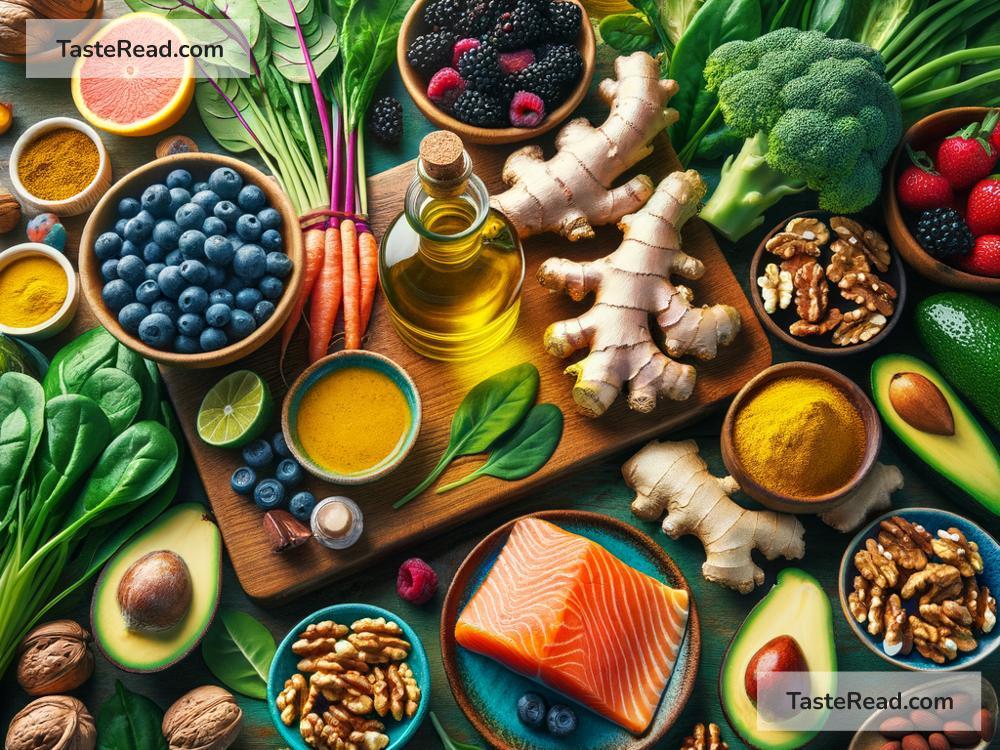Eat Your Way to Better Health: The Power of Anti-Inflammatory Foods
Have you ever heard the saying “you are what you eat”? It turns out, it’s true! The food you put into your body can have a big effect on your health, including how your body fights inflammation. But what is inflammation, and why does it matter? Let’s dig into this topic and explore how certain foods can help keep you feeling your best.
What Is Inflammation?
Inflammation is your body’s natural response to injury or infection. Think of it as your body’s way of saying, “I’m working to fix the damage.” For example, when you scrape your knee, it might swell, turn red, and feel warm. That’s inflammation at work!
While short-term (acute) inflammation is normal and helpful, long-term (chronic) inflammation can be harmful. Chronic inflammation is linked to many health problems, including heart disease, diabetes, arthritis, and even cancer. The good news is that eating the right foods can help keep chronic inflammation under control.
What Are Anti-Inflammatory Foods?
Anti-inflammatory foods are packed with nutrients that fight inflammation in the body. These foods are usually rich in vitamins, minerals, antioxidants, and healthy fats. They help reduce swelling and protect cells from damage while promoting overall health.
In contrast, highly processed foods, sugary snacks, and fried items can increase inflammation and leave your body feeling sluggish and unwell. That’s why adding anti-inflammatory foods to your daily meals is a great way to stay strong and healthy.
Top Anti-Inflammatory Foods
Here’s a list of some of the best anti-inflammatory foods you can easily add to your plate:
1. Fatty Fish
Fish like salmon, mackerel, sardines, and tuna are full of omega-3 fatty acids, which are known to fight inflammation. These healthy fats can help reduce pain and stiffness in people with arthritis and support heart and brain health. Aim to eat fatty fish at least twice a week, or use fish oil supplements if you prefer.
2. Leafy Greens
Spinach, kale, and Swiss chard aren’t just good for your vitamins—they’re packed with antioxidants that help protect your cells. They contain compounds like vitamin E, which fights harmful molecules called free radicals that trigger inflammation. Add a handful of greens to your salads, smoothies, or soups.
3. Berries
Blueberries, strawberries, raspberries, and blackberries are little burst of nutrition. They’re rich in antioxidants called anthocyanins, which reduce inflammation and lower the risk of chronic diseases. Snack on fresh berries, stir them into yogurt, or blend them into a smoothie.
4. Nuts and Seeds
Almonds, walnuts, chia seeds, and flaxseeds are great sources of anti-inflammatory healthy fats. Walnuts, for example, are high in omega-3 fatty acids, while seeds like flaxseeds provide fiber and plant-based nutrients. Sprinkle them over oatmeal, toss them into a salad, or munch on them as a snack.
5. Whole Grains
Whole grains like brown rice, quinoa, oats, and whole wheat bread are much better for fighting inflammation than their refined counterparts. They contain fiber, which helps keep your gut healthy and reduces inflammation. Choose whole grains over white bread or processed cereals whenever possible.
6. Turmeric
Turmeric is a bright yellow spice often used in Indian cooking, but it can be enjoyed by anyone. Its active ingredient, curcumin, is a powerful anti-inflammatory compound. To boost its effects, pair turmeric with black pepper—it helps your body absorb curcumin more effectively. Add turmeric to soups, teas, or stir-fries.
7. Olive Oil
Replace unhealthy fats like butter with extra virgin olive oil. It’s rich in healthy monounsaturated fats and contains a compound called oleocanthal, which has anti-inflammatory properties similar to pain-relief medications. Drizzle olive oil on your salads, veggies, or pasta dishes.
8. Green Tea
Green tea is loaded with antioxidants known as catechins, which fight inflammation and promote cell health. Drinking a cup or two daily can boost your energy while helping your body fight chronic diseases. Skip sugary drinks and sip on green tea instead for a refreshing and healthy option.
9. Dark Chocolate
Good news for chocolate lovers! Dark chocolate that contains at least 70% cocoa is rich in antioxidants and can help fight inflammation. Just remember to eat it in moderation—too much sugar can undo the benefits.
10. Garlic and Ginger
These flavor-packed ingredients not only elevate dishes but also have strong anti-inflammatory effects. Garlic contains compounds that boost the immune system, while ginger can reduce pain and improve digestion. Add them to stir-fry meals, soups, and sauces for a tasty way to improve your health.
Simple Tips for Eating Anti-Inflammatory Foods
Eating more anti-inflammatory foods is easier than you might think. Here are some tips to get started:
- Cook at Home: Preparing your own meals lets you choose fresh, whole ingredients. You can include foods like leafy greens, olive oil, and garlic in almost any recipe.
- Snack Smart: Swap chips and candy for healthier options like berries or a handful of nuts.
- Go Colorful: When filling your plate, aim for a rainbow of colors—different-colored fruits and veggies provide a range of inflammation-fighting nutrients.
- Drink Wisely: Choose water, green tea, or herbal teas over sugary drinks to hydrate your body without promoting inflammation.
Final Thoughts
You don’t have to overhaul your entire diet overnight—small changes can add up over time. Start by including more anti-inflammatory foods in your meals and reducing unhealthy options. Your body will thank you with more energy, better digestion, and long-term health benefits.
Remember, food is more than just fuel—it’s medicine. By eating the right foods, you can help your body fight inflammation and live a healthier, happier life. So, why not start today with an anti-inflammatory recipe or snack? Your health is worth it!


